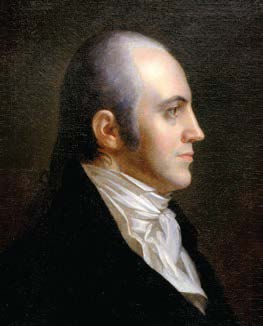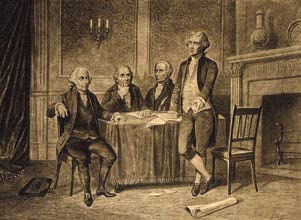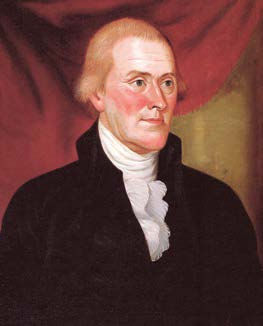Aaron Burr Challenges Alexander Hamilton to a Duel: July 11, 1804
- Catholic Textbook Project

- Jul 7, 2025
- 4 min read
This text comes from our book, The American Venture.
In the election of 1800, two Republicans vied with John Adams for the presidency—Thomas Jefferson and Aaron Burr. Technically, Burr was running to secure for himself the vice-presidential spot; but by the election rules of the time, a vice-presidential candidate had to enter the race as a presidential candidate, and Burr had higher ambitions.
“Is It Not High Time for a CHANGE?” was the Republican motto. Against Adams’ Federalist principles, Jefferson called for “strict construction” of the Constitution and for a frugal and simple federal government. He opposed a standing army as dangerous to liberty; state militias, he said, would be able to handle foreign invasions, while the navy should be large enough only to protect the country’s coasts and harbors. Against the Alien and Sedition Acts, Jefferson invoked the rights of freedom of speech and of the press.

When the three days it took to conduct the election were over, John Adams had won 65 electoral votes, while Jefferson and Burr tied, with 73 electoral votes each. Burr was supposed to yield the presidency to Jefferson, but he did not; the election, thus, was sent to the Federalist-dominated House of Representatives, which did not like Jefferson but feared insurrections if it gave the presidency to Burr. Finally, when Jefferson assured Congress that he would leave the navy alone, the Federalists joined with Republicans to elect him president.
Jefferson said the election of 1800 was as much a revolution as was that of 1776. It represented a radical change, he thought, “in the principles of our government.” Yet, even though the election of 1800 was a Republican victory, John Adams was able to strike a final blow for his Federalists and their ideas. In the two months prior to Jefferson’s inauguration in March, Adams appointed a number of Federalists to the federal courts—including John Marshall of Virginia, whom Adams named chief justice of the Supreme Court. The court decisions of Chief Justice Marshall would, in the decades to come, expand the power of the Supreme Court and of the federal government in ways Thomas Jefferson, for one, would not like.

[. . .]
The experience of the Election of 1800, where Jefferson and Burr had tied for the presidency, convinced Congress and state leaders that the Constitution had to be amended to prevent the same thing from happening again. Thus Congress approved, and in 1804 the required number of states ratified, the 12th Amendment. From now on, the election for vice president would be separate from that for president. In the election of 1804, Thomas Jefferson beat the Federalist candidate, Charles Cotesworth Pinckney, 162 electoral votes to 14.

Though as president Jefferson had striven to act as if “we are all Republicans—we are all Federalists,” he had earned the dislike of Federalists in New England and New York. These Federalists were even contemplating separating from the union and forming a “Northern Confederacy of New England and New York.” They enlisted Aaron Burr (who was no longer vice president) in their plan, but it failed when Burr did not win the governorship of New York. Because Alexander Hamilton’s opposition to his candidacy was in part responsible for Burr’s defeat, Burr challenged Hamilton to a duel and shot and killed him at Weehawken, New York, on July 11, 1804. Burr then went west where he joined in a scheme to make Louisiana an independent republic in alliance with Spain.
Federalist complaints against Jefferson did not abate in his second term but grew louder: Great Britain had intensified its boarding of American ships and the impressment of sailors. Then, in 1806, Napoleon issued his Berlin Decrees, forbidding neutral shipping (including American shipping) from entering ports of nations allied with Great Britain. In 1807, Great Britain struck back by prohibiting all trade with France or French allies. Then France declared that any ships searched by the British would be treated as enemy property and could be confiscated. In this way, American ships found themselves barred from most European ports.

When a British ship fired on an American ship in American waters, Americans were outraged, and the Federalists demanded war. Jefferson, however, resisted and called for an embargo. The Embargo Act, passed by Congress on December 22, 1807, struck the port cities of New England and New York hard, for it forbade American ships to leave American ports. Small ship owners faced ruin. Federalists in New England began to call for nullification of the Embargo Act—a very Jeffersonian idea! Finally, on March 1, 1809 (shortly before Jefferson left office), Congress repealed the Embargo Act.
But though Jefferson had certainly not been popular in New England, it seemed he remained popular with the rest of the country. In the presidential election of 1808, his hand-picked successor, the Virginian James Madison, easily defeated the Federalist Charles Cotesworth Pinckney, 122 electoral votes to 47.


